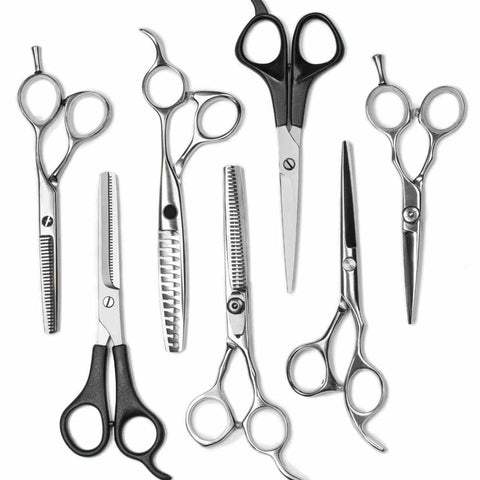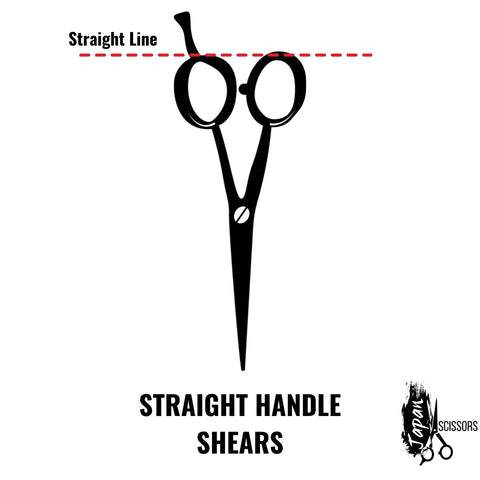Your Cart is Empty
🎉New Year 2025 Sale + Free Delivery ✨
🎉New Year 2025 Sale + Free Delivery ✨
🎉New Year 2025 Sale + Free Delivery ✨
Choosing the right hairdressing scissors can be daunting with a range of considerations to factor in.
This comprehensive FAQ guide is designed to address all these queries and more!
Irrespective of whether you're a novice embarking on your hairdressing journey or an experienced stylist in search of new shears, this guide provides the insights you need!

True ergonomic scissors have been designed to fit comfortably in your hand, with features that make it easy and natural for you to grip and use them.
An ergonomic hairdressing shear is designed to reduce the strain on yourhand and wrist, arm, shoulder, and back which can help prevent injuries. It's important to find a pair of scissors that feel comfortable for you.
Having an ergonomic pair of hair shears means that your risk of developing repetitive strain injuries such as tendonitis, carpal tunnel syndrome, and tennis elbow are much lower . You'll also be better able to work without experiencing fatigue or discomfort.

Hairdressing shear sizes are measured in inches and typically range from about 4.5" to 8" inches in length.
The most common hair scissor size used by women in salons is between 5.0" and 6.0" inches - with the most popular being 5.5" for female hairstylists.
The most popular size for men and people with large hands is usually between 6.0" and 7.0" inches.
The size of your shears (or scissors) is important, as you want to make sure they are the right length for the type of hair cutting you will be doing. Too short and your shears won't be able to cut all the hair, and too long and they will be difficult to control.
The different types of handles available for hair scissors are offset, classic straight, and crane. The most popular scissor handle type is the Offset handle because it provides a comfortable grip and is easy to use.

These handles curve away from the blades, giving you better reach for cutting hair. They are designed to help reduce strain on your wrist and thumb muscles but may feel awkward at first if you're used to holding a straight handle. The offset design makes it easier for you to cut hair at different angles without getting tired or having wrist pain from repetitive motions.

These are the second most common type of scissor handle and feel the most natural for many people. They are easy to grip and control and can be used for both right-handed and left-handed people.

These handles curve towards the blades and are designed for people with smaller hands. They provide a more comfortable grip than straight scissors handles and are perfect for people who find it difficult to grip traditional scissors handles.

Swivel scissor handles are a newer design that has been gaining in popularity. They are similar to offset scissors handles, but the curve is more pronounced and they can rotate 360 degrees. This makes it even easier for you to cut hair at different angles without having as much strain on your wrist.

The most important decision you will make when it comes to choosing the right hair-cutting scissors for your needs is what type of blade edge should I choose?
There are four types of blade edges to choose from: convex, beveled, serrated, and hollow-ground concave .
Here are the four more popular hair cutting scissor blades ranked by the most used in salons, hairdressers, and barbershops in the USA!
These are the most popular type of blade edge for hairdressing scissors. They provide a sharp and clean cut that lasts a long time because they don't dull as quickly. The convex blade edge is also easier to sharpen than other types of blade edges.
Beveled blade edges are very popular because they provide a smooth and precise cut. They are also the most common type of blade edge found on hair-cutting scissors.
The serrated blade edge is designed to grip the hair and reduce slippage. It's a good choice for people who have difficulty cutting thick hair or curly locks!
The hollow ground concave blade edge is the least popular type of blade edge, and it's not as sharp as other types of blade edges and can be difficult to sharpen. It's best used by people who need to cut very fine hair without damaging it too much.

Thinning scissors are used to thin or blend the hair. They have teeth on one blade that help remove excess bulk from thick areas of your haircut without removing too much length.
The number of teeth on a pair of thinning shears can vary, but most have between 17-30 teeth. The more teeth there are, the finer your cutting will be. Teeth that are closer together make for a finer cut, while those that are further apart make for a more coarse cut.

There are many different types of steel used to make scissors. Today, the most popular steels used in hairdressing shears include Japanese, German, Korean, and Taiwanese Steel.
Japan Scissors USA ranks each hairdressing shear-type with a quality ranking. Professionals should choose a pair of scissor steel with a 3 star or higher ranking!
The main reason some hair scissors are so expensive is the premium quality steel used in the manufacturing process.
A good hairdressing scissor should feel comfortable in your hand and allow you to cut hair with ease. It's important that the scissors are the correct weight for your hand and that the handles are the right size, weight, handle and body shape.
Hair scissors and hair shears are relatively the same. Most marketing material for professional hairdressing scissors uses the term "scissor" and "shear" interchangeably when describing their products.
Some scissors are heavier than others because they have different blade edges. Heavier blades make the scissor more durable and able to cut through tougher hair types.
Lighter scissors are designed for precision cutting and have a sharper blade edge that is easier to control. They're perfect for cutting fine hair without damaging it.
There are many designs on the market, and one way they differ is the weight.
While some people prefer a thicker shear, stylists generally prefer a thinner scissor.
Be aware of your preferences and ensure that the amount of force of the scissor is comfortable and you feel the feeling of being in control right up until the point of your blade.
Additionally lighter shears can't cut through thick hair in the same way as the heavier, more thick blades.

Scissor finger inserts/rings are small plastic rings that are placed over the fingers to help protect them from sharp blades. They're also used to improve the grip on the scissors and make them more comfortable to hold.
Scissor finger inserts/rings are a great way to prevent cuts and injuries while cutting hair. They're also useful for improving the grip of your scissors, making them more comfortable to hold.
There are many different types of hairdressing scissors, each designed for a specific purpose. Some scissors are made to cut through thick hair, while others are designed for precision cutting.
Here are some of the most common types of hair scissors:
Yes, a left-handed hairstylist can use right-handed scissors. However, they won't be as comfortable to use or work as well as left-handed scissors.
Left-handed hairstylists should always use true left-handed scissors to achieve the best results when cutting hair. Using a real left-handed handle hair shear will reduce the risk of repetitive strain injuries (RSI) and help make hair cutting easier and more comfortable.
There is no definitive answer to this question. Some people may prefer brands that are known for their quality and durability, while others may prefer brands that offer a wide variety of scissors styles to choose from.
A good hair scissor brand delivers reliable hairdressing shears that suit your price, style, and haircutting techniques.
It is important to do your research before buying hair scissors and read reviews from other customers who have purchased the same type of scissors.
Yes, all hair scissors need to be sharpened eventually. The type of steel used in the manufacturing process and the blade edge will determine how often the scissors will need sharpening.
Convex blade edges and Japanese stainless steel shears are some of the best types of hair scissors that hold their sharpness the longest.
Beveled blade edges and carbon steel shears are two of the worst types of hair scissors for retaining a sharp edge.
Yes, you can sharpen your hairdressing scissors at home using a sharpening stone or diamond sharpener.
However, it's important that you use the correct type of sharpener to avoid damaging the blades. If you make a mistake while sharpening your scissors, you could permanently ruin the blade.
You should sharpen your hairdressing shears when they start to become blunt. This will help maintain the sharpness of the blades and keep them performing at their best.
Hair shears are sharpened as often as they are used. Based on research from American salons and barbershops, a regularly used hair cutting shear is sharpened every three to nine months.
Cutting your hair seems easy enough to do in the videos, but it's more difficult to achieve an ideal cut than you believe.
The majority of people who attempt at cutting their hair will end up with an uneven cut and are also more likely to end up damaging their hair.
The main reason why hair gets damaged and uneven is due to the scissors used by people aren't sharp enough. Sharp scissors will give you more precise cuts and won't damage the edges of hair much as badly. Imagine cutting fabric.
If you are using ordinary dull scissors to cut fabric, you'll get cut edges that are frayed or broken. You do not wish for your hair to be cut exactly the same way, so make sure you choose scissors that are smooth and sharp.
Of course, the majority of people aren't able to determine if their scissors can cut hair. This article will assist you to determine if your scissors are capable of cutting your hair and also why you should choose hair scissors instead of kitchen ones.
You can adjust the tension on your hair scissors by using a screwdriver or tension key to loosen or tighten the screws.
Make sure not to over-tighten the screws as this could damage the scissors.
Ensure that the tension is tight enough so that the blades don't fall open by their own weight, but not so tight that the blades scrape together as they open and close.
Subscribe to our newsletter for sales, discounts and hairdressing & barber news!